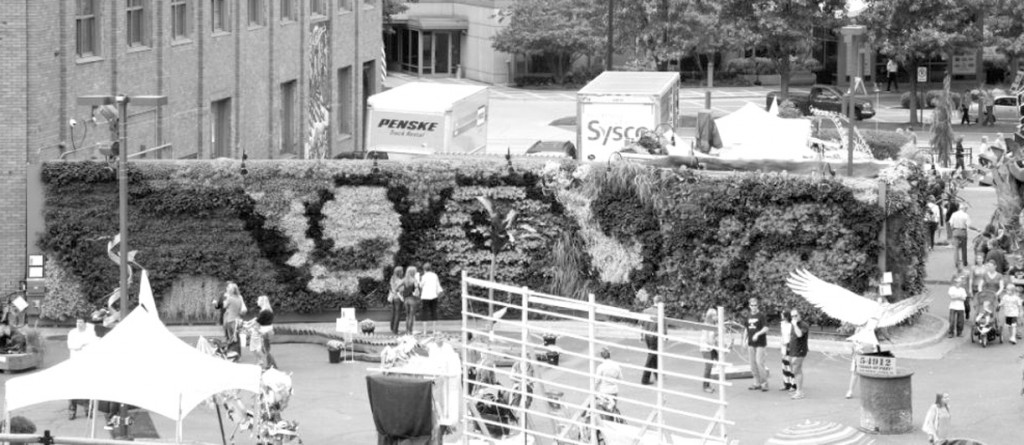The Muskegon Museum of Art’s 86th Regional Exhibition, the longest-established regional art exhibition in Michigan, opened for public viewing Thursday, May 22, and will run through August 20.
The MMA’s annual, juried Regional Exhibition, known for its competitive nature and for its professional presentation, is open to amateur and professional artists throughout Michigan. This year, 299 artists submitted a total of 501 works for the competition. Guest juror David L. Deming selected 200 works by 162 artists for the exhibition. This exhibition of artwork in many mediums, themes, and styles will be displayed in the MMA’s Walker Galleries throughout the summer. Most of the artwork in the exhibition is available for sale.
This year’s juror, Cleveland sculptor David Deming, was President and CEO of the Cleveland Institute of Art from 1998 through 2010. He developed the school’s first digital arts department, and launching the plan for the Institute’s new campus. He has participated in more than 100 competitive and invitational exhibitions, nationally and internationally, and in more than 50 one-and two-person exhibitions.
The 86th Regional Exhibition is underwritten by Shape Corporation, Warner Norcross & Judd, LLP, and the MMA’s Ally for Contemporary Art, the Alcoa Foundation. Awards are sponsored by Huntington Bank. Additional support is provided by the Michigan Council for Arts and Cultural Affairs, the National Endowment for the Arts, and MLive/Chronicle.
The Muskegon Museum of Art is located at 296 W. Webster Ave. in downtown Muskegon. Call 231-720-2570 or visit www.muskegonartmuseum.org for information.
MMA 86th Regional Exhibition Artist Awards
CASH AWARDS

Best of Show | $1,500
Joshua Adam Risner, Alto, Inness’s Daughter

2nd Place | $750
Michelle Newman, Muskegon, Mid-Century Muse

3rd Place | $500
Lisa Olsen, Grand Rapids, Slumber II

Director’s Choice | $500
Janet Tyson, Spring Lake, Hive

Curator’s Choice | $500
Katherine Bourdon, Muskegon, When Women Were Birds

Gordon Hall Memorial Award | $300
Sy Ellens, Kalamazoo, Neglected
Friends of Art | $250
Lee Ann Frame, Fruitport, Escape

West Michigan Potter’s Guild Eleanore Smith Memorial Award | $250
Cary A. Vander Veen, Lawton, Spring Fever
Robert and Veronica Youngman Memorial Award for Graphic Arts | $150
Armin Mersmann, Midland, Best Laid Plans
William L. “Bill” Rogers Best Photography | $150
Robert C. Stone, Grand Rapids, Perkins Cove
Docents’ Choice | $100
Shelley Dingman, Muskegon, Muskegon Door
Honorable Mentions |$100
Lee S. Brown, Muskegon, Bound Column X
Jennifer Green, Whitehall, Street #1
Nancy Oakes-Hall, Grand Rapids, Anger Management
SPONSORED PURCHASE AWARDS (sponsor listed first)
ADAC Automotive
• Lois Ann Rodgers, Holland, The Tulgy Wood
AGS (American Grease Stick)
• Neil Mullally, Muskegon, Tucson Mission
• Karen Hoekstra, Grand Rapids, And the Earth Responds
Sherry Becker
• Lindy Crandell, Grand Rapids, Aunt Marjorie at 3 – 1924
Community Foundation for Muskegon County
• Mark Kirby, Muskegon, Drasland
• Holly Sturges, Grand Rapids, Thoreson Outhouse
• Holly Sturges, Grand Rapids, The Flume
Carla Hill
• Michelle Newman, Muskegon, Mid-Century Muse
Grand Valley State University Art Gallery
• Marc Hoeksema, Muskegon, Forest
• Lisa Olsen, Grand Rapids, Slumber II
Brian and Jamie Lang
• Andrew Jagniecki, Whitehall, A Murder of Crows
• Nancy Oakes-Hall, Grand Rapids, Anger Management
Patrick J. O’Leary
• Janet Tyson, Spring Lake, Hive
• Robert C. Stone, Grand Rapids, Perkins Cove
Warner, Norcross, & Judd
• Dianne Carroll Burdick, Grand Rapids, Water for Trees
• Sy Ellens, Kalamazoo, Water Wonderland
• Gale Nobes, Muskegon, Being
• Gale Nobes, Muskegon, Treeline
West Michigan Symphony
• Abbey Fitzpatrick, Spring Lake, Almighty Grid #3
Chris and Stephanie Witham
• Kathleen Kalinowski, Comstock Park, River Banks, Spring Thaw
• Connie Kuhnle, Rockford, Market Hydrangea
Marilyn and Richard Witham
• Tom Tomasek, Ovid, Wetlands
VISITOR INFORMATION
The Muskegon Museum of Art is located at 296 W. Webster Ave. in downtown Muskegon.
Call 231-720-2570 or visit www.muskegonartmuseum.org for information.











 Do you remember the Art Prize 2013 LiveWall entry called “Back to Eden?” It is located at the B.O.B. in Grand Rapids. It is a 1,400 square foot living wall and was among the top 25 winners.
Do you remember the Art Prize 2013 LiveWall entry called “Back to Eden?” It is located at the B.O.B. in Grand Rapids. It is a 1,400 square foot living wall and was among the top 25 winners.
 The gallery also features a small replica of the office at the Hackley and Hume Lumber Company. It includes an office chair, a desk we believe was original to the company, and a map of the lumber mills that lined the shores of Muskegon Lake. “The Journey from Forest to the Lumberyard” exhibit uses photographs, labels and artifacts to tell the story of lumbering in Muskegon.
The gallery also features a small replica of the office at the Hackley and Hume Lumber Company. It includes an office chair, a desk we believe was original to the company, and a map of the lumber mills that lined the shores of Muskegon Lake. “The Journey from Forest to the Lumberyard” exhibit uses photographs, labels and artifacts to tell the story of lumbering in Muskegon.